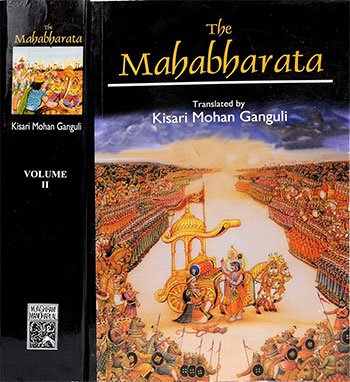Section XCI - Arjuna defeats Srutayudha and Sudakshina in battle
Book index: Mahabharata (English)
This page contains a summary of the Mahabharata Section XCI including examples of moral lessons in daily life. The Maha-Bharata is one of the largest epics ever written containing roughly 100,000 Sanskrit verses. It deals with the legendary history of ancient India and contains a large number of interwoven tales.
Short summary of the chapter:
The battle between Arjuna and Drona raged on fiercely, with both warriors unleashing a storm of arrows upon each other. Arjuna, invoking the Brahma weapon, skillfully defended against Drona's attacks, causing havoc in the enemy army. Despite their intense confrontation, Arjuna could not pierce Drona with a single arrow, showcasing the preceptor's remarkable skill and defense.
As the battle continued, Arjuna faced off against Kritavarman and Srutayudha, both fierce opponents determined to take down the mighty warrior. Kritavarman and Srutayudha exchanged blows with Arjuna, but ultimately fell before his superior prowess. Srutayudha, armed with an invincible mace granted by Varuna, met his demise when his weapon turned back on him, fulfilling the conditions of his boon.
Sudakshina, the prince of the Kamvojas, then entered the fray and confronted Arjuna in a fierce combat. Despite Sudakshina's valiant efforts, Arjuna's skill and strategy overpowered him, leading to his defeat on the battlefield. Arjuna's arrows pierced Sudakshina's armor, causing him to fall lifeless to the ground, like a majestic tree uprooted in a storm.
With the fall of Srutayudha and Sudakshina, the morale of the enemy troops wavered, and they fled the battlefield, witnessing the prowess of Arjuna. The son of Pandu emerged victorious, displaying his unmatched archery skills and strategic brilliance in the face of formidable opponents. The battlefield was littered with fallen warriors and broken chariots, a testament to the ferocity and intensity of the battle.
The story of Arjuna's triumph over Drona, Kritavarman, Srutayudha, and Sudakshina showcases his unmatched skill in combat and unwavering determination to fulfill his duties as a warrior. Despite facing powerful adversaries, Arjuna prevailed through his precision, agility, and strategic acumen, leaving a trail of destruction in his wake. The enemies who dared to challenge him were swiftly defeated, reinforcing Arjuna's reputation as a formidable warrior and a key player in the Kurukshetra war.
Full English translation:
This page is merely a summary which is automatically generated. If you are looking for authentic sources such as the Sanskrit text or the Full English translation of Mahabharata Section XCI - Arjuna defeats Srutayudha and Sudakshina in battle, have a look at the following articles:
Section XCI, online text
English translation by Kisari Mohan Ganguli.
Read this and other chapters online.
Mahabharata (English Summary)
by Kisari Mohan Ganguli | ISBN-10: 8121505933
Buy the latest edition:
FAQ of Mahabharata, Section XCI:
Who was Srutayudha and why was he considered invincible on earth?
Srutayudha was the son of Varuna and the river Parnasa, and he was considered invincible on earth due to a celestial weapon bestowed upon him by Varuna.
How did Srutayudha meet his demise in the battle?
Srutayudha disobeyed an injunction and hurled his mace at Janardana, which ultimately rebounded and struck Srutayudha, leading to his death.
What was Sudakshina's fate in the battle with Arjuna?
Sudakshina, the prince of the Kamvojas, was defeated by Arjuna in battle and ultimately slain by his arrows on the battlefield.
How did Arjuna's combat skills shine in the battle against his opponents?
Arjuna showcased his exceptional combat skills by outmaneuvering and defeating formidable opponents like Drona, Kritavarman, Srutayudha, and Sudakshina, inflicting heavy casualties on them.
Daily life: Arjuna defeats Srutayudha and Sudakshina in battle:
The excerpt from the ancient epic Mahabharata details a fierce battle, showcasing courage, strategy, and the adherence to one's duties despite overwhelming challenges. In the narrative, characters like Arjuna and Krishna demonstrate immense bravery and quick thinking in the face of adversity, from which we can extract valuable life lessons.
From this narrative, we learn the importance of resilience and adaptability. Life will often test us through various challenges, akin to the battles faced by the warriors in the story. Like Arjuna, who faced formidable opponents and obstacles on the battlefield, we too encounter difficulties in our personal and professional lives. The key takeaway is to remain steadfast in our pursuits, adapting strategies as necessary, while maintaining a strong sense of duty and purpose.
Moreover, the story highlights the significance of mentorship and camaraderie. Krishna’s guidance to Arjuna underlines the value of having a trusted advisor or friend to provide perspective and encouragement. This reminds us to seek support when faced with daunting situations, drawing upon the wisdom and strength of our mentors and peers to navigate through tough times.
Finally, the concept of facing the consequences of one's actions, as illustrated by Srutayudha’s fate when he went against a given warning, serves as a powerful reminder of accountability. It teaches us to be mindful of our decisions and actions, understanding that they have impacts and that we must be prepared to accept the outcomes.
Incorporating these principles into our daily lives—resilience in adversity, valuing relationships and mentorship, and being accountable for our actions—can significantly influence our ability to meet life's challenges head-on, leading to personal growth and success.
